#learning to read
Photo
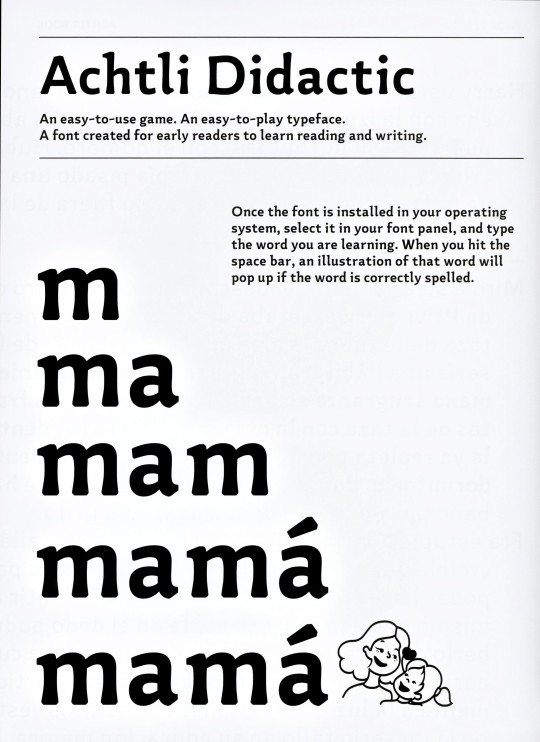




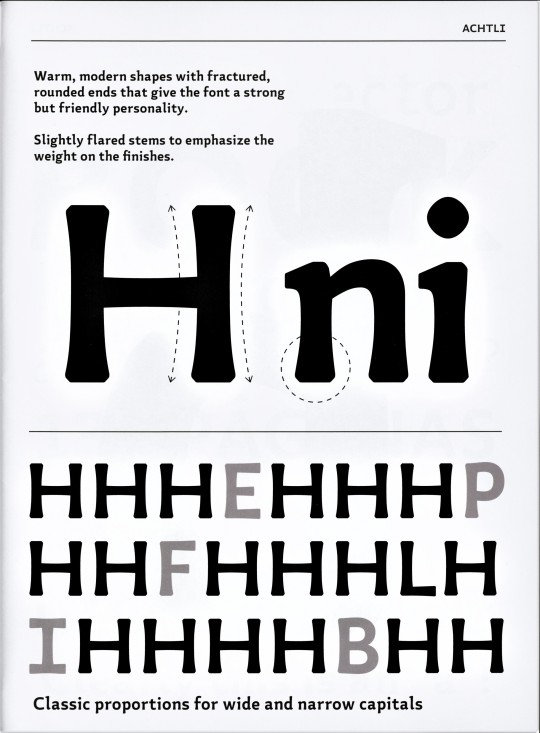
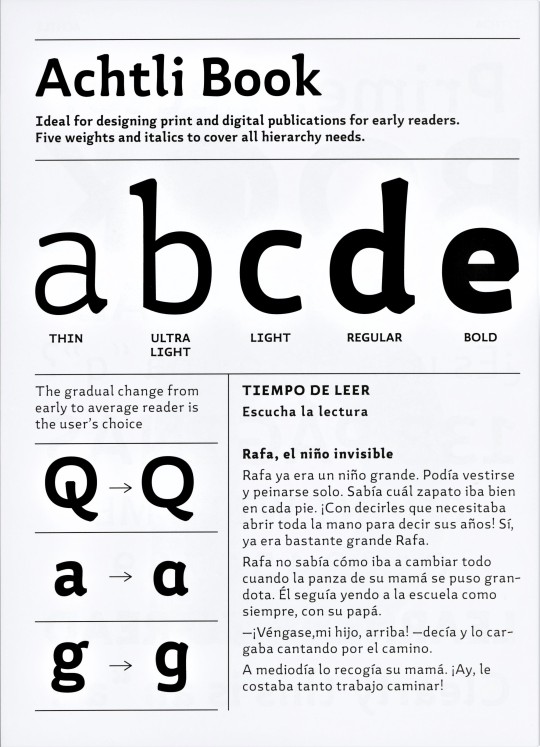

Typography Tuesday
Women Type Designers: SANDRA GARCÍA & DAFNE MARTÍNEZ
Sandra García, born and raised in Colombia, and Dafne Martínez, born and raised in Mexico, are young designers based in Mexico City. As part of the 2021 Typographer-in-Residence program organized by the Hoffmitz Milken Center for Typography, they designed the typeface Achtli specifically to improve the experience of learning to read in young children. They write:
We conducted a field study with primary school students between the ages of five and seven who were in the process of learning to read. . . . We also interviewed teachers to understand what difficulties they encountered in teaching the reading process and the use of typography. . . . After analyzing the results, we reached the following conclusions: Typefaces with similar morphological forms make it difficult for early readers to distinguish some characters from others. A typeface with distinct qualities could assist their memory to identify and differentiate them more efficiently. . . . [The Achtli typefaces has] unique, distinctive properties, with moderate contrast, semi serif endings, and slightly flared stems to emphasize the weight on the endings. The warm, modern shapes with fractured, rounded ends give the typeface a bold yet friendly personality.
The name Achtli is the Nahuatl word for “seed,” a metaphor for reading, as learning to read is like a good seed that grows and flourishes. The examples shown here are from Achtli: A Typeface for Early Readers, one of four volumes in the set Mujeres Hispanas y Tipografía, a program highlighting the talent and creativity of Hispanic women designers, published in Pasadena, California by the Hoffmitz Milken Center for Typography in 2022.

Sandra García
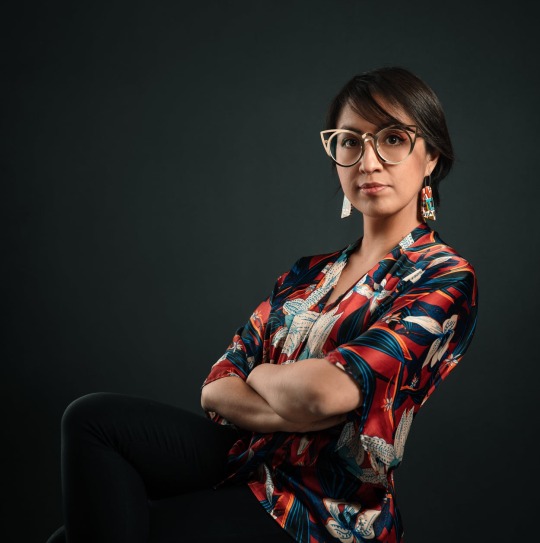
Dafne Martínez

View posts on other Women Type Designers.
View more Women’s History Month posts.
View more Typography Tuesday posts.
#Typography Tuesday#typetuesday#Typography Tuesday#women's history month#Dafne Martínez#Sandra García#type designers#women type designers#women designers#Achtli typeface#early readers#learning to read#type for children#Hoffmitz Milken Center for Typography#Achtli: A Typeface for Early Readers#Mujeres Hispanas y Tipografía#Nahuatl
69 notes
·
View notes
Text


#NWACS#full time aac user#aac user#reading#learning to read#nonverbal#actually nonverbal#nonverbal communication
13 notes
·
View notes
Text
She watched him with a kind of gratified awe. He'd been barely able to read when he'd arrived, but the goblin boy had set out to improve his reading as a boxer trains for a fight. And he was fighting something, but she wasn't sure in her own mind what it was and, of course, her Ladyship never explained. He would sit all night under the lamp, book of the moment in front of him, dictionary and thesaurus on either side, wringing the meaning out of every word, punching ceaselessly at his own ignorance.
Terry Pratchett, Unseen Academicals
#nutt#miss healstether#lady margolotta#unseen academicals#discworld#terry pratchett#library#librarians#reading#book#literacy#learning to read#knowledge#training#preparation#self improvement#self discipline#dictionary#thesaurus#power of books#ignorance#he was fighting something
363 notes
·
View notes
Photo
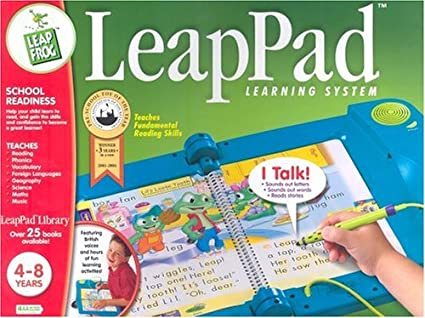



The LeapFrog LeapPad
(original model, 2004)
#i loved these#I especially liked putting the pen on objects or background pictures to hear the words for them#leapfrog#leafpad#childhood memories#learning to read#throwback#nostalgia#childhood nostalgia#early 2000s#90s kids
297 notes
·
View notes
Text
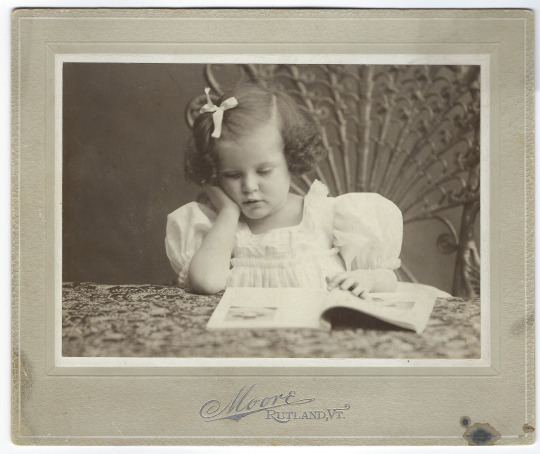
Fundamental. Mounted photo of a pretty little girl sitting in a rattan chair reading a picture book. Moore studio, Rutland, Vt.
https://markonpark.etsy.com/listing/1496344947
4 notes
·
View notes
Text
I taught my younger sibling to read with my collection of Ladybird books, long since out of print. They were the Puddle Lane series and we both loved them.
My sibling especially liked the books about the Iron Boy and Sandalwood Girl. I used to read those until we both knew them by heart.
We also had a couple of episodes still on VHS tape, which we used to enjoy watching together. I don't think they had a favourite one, but I think mine was about the Magician (the brilliant Neil Innes) accidentally turning himself green when he was taking inventory of his magic items. He'd forgotten what some of them did and tested them, knowing that he wouldn't make anything that was dangerous.
Couldn't find that one on YouTube, but there are lots of others. Here's another that I also remember fondly:
#Neil Innes#Puddle Lane#fond memories#learning to read#childhood books#childhood tv shows#me and my sibling#ladybird books
4 notes
·
View notes
Link
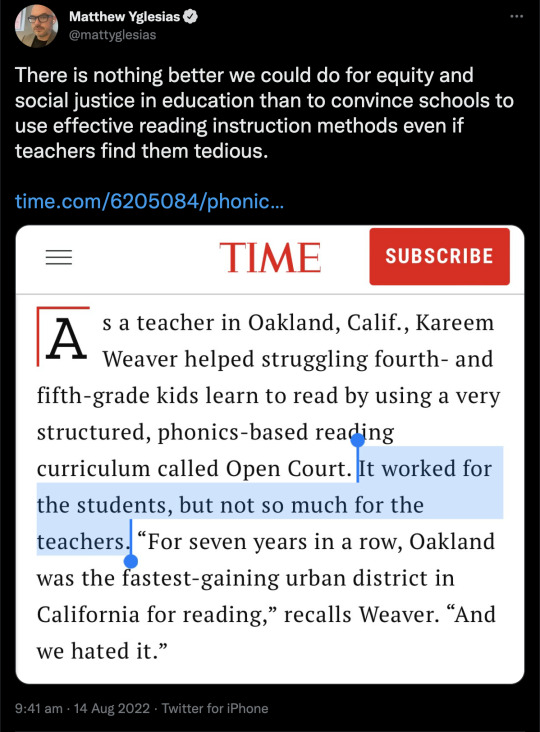
By: Belinda Luscombe
Published: Aug 11, 2022
As a teacher in Oakland, Calif., Kareem Weaver helped struggling fourth- and fifth-grade kids learn to read by using a very structured, phonics-based reading curriculum called Open Court. It worked for the students, but not so much for the teachers. “For seven years in a row, Oakland was the fastest-gaining urban district in California for reading,” recalls Weaver. “And we hated it.”
The teachers felt like curriculum robots—and pushed back. “This seems dehumanizing, this is colonizing, this is the man telling us what to do,” says Weaver, describing their response to the approach. “So we fought tooth and nail as a teacher group to throw that out.” It was replaced in 2015 by a curriculum that emphasized rich literary experiences. “Those who wanted to fight for social justice, they figured that this new progressive way of teaching reading was the way,” he says.
Now Weaver is heading up a campaign to get his old school district to reinstate many of the methods that teachers resisted so strongly: specifically, systematic and consistent instruction in phonemic awareness and phonics. “In Oakland, when you have 19% of Black kids reading—that can’t be maintained in the society,” says Weaver, who received an early and vivid lesson in the value of literacy in 1984 after his cousin got out of prison and told him the other inmates stopped harassing him when they realized he could read their mail to them. “It has been an unmitigated disaster.” In January 2021, the local branch of the NAACP filed an administrative petition with the Oakland unified school district (OUSD) to ask it to include “explicit instruction for phonemic awareness, phonics, fluency, vocabulary, and comprehension” in its curriculum.
Weaver and his co-petitioners—including civil rights, educational, and literacy groups—want schools to spend more time in the youngest grades teaching the sounds that make up words and the letters that represent those sounds. His petition is part of an enormous rethink of reading instruction that is sweeping the U.S. So far this year, five states have passed laws that require training for teachers in phonics-based reading techniques, adding to the 13 that passed such laws last year. And in May, New York City Mayor Eric Adams announced that elementary schools in the biggest district in the country would be required to adopt a phonics-based reading program.
The timing for such a dramatic change feels especially challenging. Elementary-school teachers are already having to recalibrate after two years of disruption; vicious fighting about public-health mandates as well as what kids should be taught about race and gender; and a widespread parental freak-out about how little their children have learned during the pandemic. Now the most fundamental skill that society asks them to pass along is also being completely shaken up.
But advocates say it cannot wait: in 2019, even before the pandemic upended instruction, only 35% of fourth-graders met the standards for reading proficiency set by the National Assessment of Educational Progress, an even lower number than in 2017. Only 21% of low-income students (measured by whether they qualify for free school lunch), 18% of Black students, and 23% of Hispanic students can be considered on track for reading by fourth grade. These numbers have been low for decades, but the pandemic has given the dismal results extra urgency. “There have been choices made where our children were not in the center,” says Weaver. “We abandoned what worked because we didn’t like how it felt to us as adults, when actually, the social-justice thing to do is to teach them explicitly how to read.”
While reading is a foundational skill, it is not a natural one. Given enough time around other humans, the vast majority of youngsters will learn to walk upright and talk. For most children, however, recognizing that certain squiggles on a page or screen correspond to certain sounds requires painstaking instruction. In all, the 26 letters of the English alphabet can be combined to make about 44 sounds (depending on your accent). When those sounds are put together, they create 15,000 syllables and untold numbers of words. Ideally, children figure out what the letter string says at about the same moment a word they already know crystallizes into view. And after a couple of those aha moments, usually starting in first and second grade, when nicky reveals itself as nice or kahy-ef transforms into chief, the word seems to move into permanent memory. This is known as the simple view of reading: it’s the product of a robust ability to decode letters, and a strong vocabulary.
There are many schools of thought on how best to aid this process, but the main contretemps has been about whether kids need to be taught how to sound out words explicitly or whether, if you give them enough examples and time, they’ll figure out the patterns. The latter theory, sometimes known as whole language, says teaching phonics is boring and repetitive, and a large percentage of English words diverge from the rules. (Hello there, though, thought, through, trough and tough!) But if you immerse children in beautiful stories, they’ll be motivated to crack the code, to recognize each word. The counterargument is that reading is as connected to hearing as it is to sight. It begins, phonics advocates say, with speech. This understanding, and the data that supports it, has become known as the science of reading.
This debate was supposedly settled in 2000, when the National Reading Panel, a big group of literacy experts that examined hundreds of studies on what instruction kids need to read, released a report. It recommended explicit instruction in the things Weaver’s petition asks for: phonemic awareness, phonics, fluency, vocabulary, and comprehension. This was a victory for the phonics camps. But it is one thing to declare a war is over and another to parcel out territory.
Thus was born the notion of balanced literacy, which was an attempt to correct the ship’s course, rather than turn it around completely. Schools would introduce more instruction in the link between sounds and letters, but that could be sprinkled in with other methods teachers thought worked, like prompting kids to use context clues (including, say, pictures) when they came to a word they didn’t know.

The net result, says Timothy Shanahan, a former director of reading for Chicago schools and an early-literacy expert who was on the panel, was that balanced literacy came to mean whatever anybody wanted it to. Schools did not have to buy expensive new curriculums. Districts did not have to retrain their teachers. Teachers could add some lessons on phonics, but they didn’t have to hit reset on the way they taught. A 2019 survey of more than 600 elementary-school teachers by Education Week found that more than two-thirds used a balanced-literacy philosophy, although most also said they incorporated “a lot” of phonics. “The idea was each group would get some of what they wanted,” says Shanahan. “I’ve got to admit, I always thought that was a bad idea. It seemed to me that you should just go with the research.”
* * *
Reading scores did not improve much after balanced literacy was introduced, but they didn’t plummet, either. Things might have stumbled along in much the same way, except that education departments around the country had begun to earn the ire of a particularly determined group: the parents of dyslexic children. People with dyslexia take much longer to sort out the connection between sound and symbol. The immersion method of teaching was simply not going to work for them. Pressure from these parents, plus some crusading journalism, a steady stream of research, impressive results from several school districts, and heightened concern about pandemic learning loss, have finally turned the tide back toward a stronger emphasis on phonics.
Dyslexia is not linked to intelligence; it has been described as an island of weakness surrounded by a sea of strength. It has no cure but can be overcome. So when some wealthy, well-educated parents found their otherwise typical children were not learning to read, they had questions for the school. These were met in many cases with the advice to read to them more. The parents then did what educated, wealthy people do when they feel slighted: they looked at the research, paid for expensive testing, called their representatives, and contacted their friends in the press.
What they found was that the methods many teachers were using were not supported by the data. They were supported by theories, observations, hopes, and, some would argue, a few guru-like figures. Just as most children, no matter how many times they’ve been in a car, still need to be taught to drive, most readers benefit from being explicitly taught how sounds and letters go together. This is true not just for dyslexics (who represent about 10% of all learners) but for the majority of readers.
Some of the data these parents uncovered comes from the world of neuroscience. Cognitive scientists have found that as a child reads a word, the networks in the brain associated with vision activate first, followed by the areas of the brain associated with speech. There are also subtle but detectable changes in the brain as children learn to read, primarily a growth in the fibers that connect the areas associated with speech and vision. French neuroscientist Stanislas Dehaene, in his 2009 book Reading in the Brain, calls this area “the letterbox.” His studies suggest that the brain never really learns to read a whole word, it just gets really, really fast at decoding. He believes that any type of learning that does not emphasize the sound of words is inefficient.
About a decade after his book was released, Emily Hanford, an education reporter at American Public Media—after being contacted by dyslexia activists—did a multipart audio documentary on why the National Reading Panel’s recommendations and all the research were so blithely ignored. It was she who popularized the phrase the science of reading.
State legislatures, which have been getting an earful from dyslexia activists for years, have begun to act. From 2013 to Aug. 1, 30 states have passed laws or enacted new policies related to “evidence-based” reading instruction. Mississippi was one of the first, and in 2019 it became the only state in the nation to meaningfully improve its fourth-grade reading scores. The results were touted as the “Mississippi Miracle.”
As the pandemic stretched on and children missed a lot of school, parents became increasingly worried about how their kids would catch up and looked for such a miracle. Kymyona Burk, who helped implement the changes in Mississippi and is now a policy fellow at think tank ExcelinEd, says she met “a lot of parents who may have been involved but not engaged. They would show up to PTA meetings and sign progress reports but didn’t really understand what went on in the school.” COVID-19 may have changed that. “To be at home and to sit beside your child, or to hear your child in the other room with virtual learning?” says Burk. “Parents learned a lot.”
But even with the Holy Trinity of school change—legislatures, researchers, and activist parents—on the case, getting teachers to use new techniques has been an uphill battle. “Passing the law was the first step for us, and it was the easy thing,” says Burk. What others tout as a miracle, she notes, was more like a slow climb, with steadfast funding, tireless messaging, and a top-to-bottom reorganization of the way Mississippi’s youngest readers were taught. “The hardest part was convincing others who had done things a certain way for such a long time that we needed to make a shift. We had to make a shift in our instructional practices; we had to make a shift in the curricula that we were purchasing; and also we had to just really come to terms with the fact that there were so many of our teachers who had come through our education-preparation programs who still were not equipped to teach children who struggle how to read.”
Mississippi retrained all its teachers using LETRS (Language Essentials for Teachers of Reading and Spelling), an intensive training module that takes them all the way back to understanding the sounds in speech, what is known as phonemic awareness. Many states have followed suit. But retraining busy teachers takes a while and doesn’t necessarily change what they do in the classroom. “There are tens of thousands of schools in the United States, and nobody really monitors what goes on in those schools,” says Shanahan, who in nonpandemic times visits 40 or 50 schools a year. “A lot of times the teachers have no idea that they’re not teaching things that are beneficial to the kids.”
Even if the teachers are equipped to teach a new way, they need the support of their principals and superintendents. Stacey Pim, an elementary reading specialist in Virginia, began to use more of her instruction time to teach first-grade students letter-sound correspondence in the fall of 2020, after she noticed that in prior years, the skills of first-graders at her school had not improved. “By the time they got to second grade, we were having a whole classroom of children who were below grade level,” she says. Moreover, because of the pandemic learning gaps, she felt her students were not able to tackle the work that the curriculum was offering. But, she says, her administrator told her she needed to stay with her school’s balanced-literacy program. Feeling stuck, and with her own kids to deal with, she resigned. (Only 18 months later, in April 2022, Virginia enacted new “evidence-based” teacher-training regulations.)
Pim was not alone. The pandemic was extremely hard on teachers, typically nurturing, underpaid souls who got into the profession because they wanted to help others. Recent surveys have showed a sharp uptick in those wanting to leave the profession early. Making matters worse, the discussion about reading quickly became like so many others in education: less about children and improving techniques and more about finger-pointing and blame. It also became politicized, since it was mostly progressive states that used methods that leaned toward child-led learning and more conservative ones that embraced the traditional phonics-heavy methods.
When Kari Yates, a former school principal and literacy manager in Minnesota who used the balanced-literacy-based Reading Recovery program to help struggling readers, heard that teachers in her district were going to have LETRS training, she thought she’d check it out. “I don’t think I anticipated going into it that I was going to be as triggered as I was,” says Yates. The language used seemed to belittle the work of those like her who had toiled for years to teach children to read using less phonics-forward methods.
Yates’ friend and writing partner Jan Burkins had also heard about this so-called science of reading and started looking at research to debunk it. Instead, she too became increasingly convinced that Emily Hanford’s reporting was right. “We began to realize, Oh, there are some things that we’ve been doing that actually make it harder for children to learn to read,” she says. “And there are some relatively simple ways to shift some practices that make it easier.” Burkins and Yates wrote a new book, Shifting the Balance, to try to build a bridge between the two camps. It is selling well, but the duo are wary of its success because it leaves them open to attacks from both sides. “People I’ve had great respect for in the field are being really criticized,” says Yates.
The two write that they had to make a pact not to give in to defensiveness as they discussed why approaches such as the use of leveled readers (which predict what kinds of stories children should be reading) should be discarded in favor of decodable texts (which give them a lot of opportunities to practice sound-letter correspondence) as well as the problems with what’s known as cueing, where teachers get children to ask a lot of questions about the word they’re stuck on, rather than just sounding out. “Moving away from a model of reading that is strategic to one that is more aligned with what we know from the inside out about what the brain is doing when we’re reading, it’s a big, hard thing for teachers,” says Burkins.
The difficulty of getting teachers fully on board is one of the reasons Shanahan is wary of saying the change is here to stay. “This [shift] happens with some regularity in this field,” he says. “I’ve been doing this for more than 50 years, and this is about the third one I’ve been through.” This time is a little different, he acknowledges, because more mainstream media outlets have taken an interest in something that is usually the preserve of academia. And this is the first pendulum swing in the era of social media. A Facebook group called The Science of Reading—What I Should Have Learned in College has more than 165,000 members, most of them aggrieved parents or bewildered and angry teachers.
Hanford’s reporting laid the blame for the neglect of a foundational reading practice largely at two doors: curriculum publishers, which market programs that critics say are not supported by science; and schools of education, which are slow to change the way they teach teachers to teach reading. It singled out Irene Fountas and Gay Su Pinnell’s Leveled Literacy Intervention, which is used by about 43% of K-2 teachers in the U.S. and suggests that students can get information about words from sources other than the letters, and Lucy Calkins’ Units of Study for Teaching Reading, which is used by 14%, including, until recently, Oakland schools. (An OUSD spokesperson says it adopted a new curriculum in May 2021 and is also examining new phonics programs.)
Four years after Hanford’s first story on the issue ran, those things too are finally changing—a little. Calkins, the founding director of the Teachers College Reading and Writing Project at Columbia University and a prominent figure in the field of early reading, added more emphasis on the explicit teaching of phonics to her most recent version of the curriculum, although her critics contend it’s not enough. Fountas and Pinnell remain holdouts, saying in a recent series of blog posts that their work has been mischaracterized. None of these authors agreed to be interviewed.
It’s probably too soon to accurately assess the impact of the pandemic on children’s learning. A McKinsey report found that students in 2021 were about four months behind in reading compared with nonpandemic years. The Brookings Institute found a 15% increase in the gaps in reading proficiency between students at the wealthiest and most impoverished schools. A study out of the Netherlands found that even a relatively short eight-week lockdown led to a learning loss of a fifth of a year. But it’s not all bad news. A lot of states are using their federal COVID-19 relief funds to buy new curriculum, retrain teachers, and hire literacy coaches. One of them, Tennessee, recently announced that its 2022 fourth-grade reading scores surpassed pre-pandemic levels, though still only about 40% met or exceeded standards.
The stakes couldn’t be higher. Fourth grade is a key moment in a child’s education. Until then, as the old saying goes, children are learning to read; after that they’re reading to learn. If they can’t, things head south. A 2011 study from the Annie E. Casey Foundation found that students who don’t read proficiently by the end of third grade are four times as likely to eventually drop out of school as those who do.
Not every child needs systematic instruction in phonics. Some can figure out the patterns for themselves. And phonics instruction alone is not enough. But the past several decades seem to have proved that a more intense focus on the letter sounds hurts nobody, and the many children who need it flounder without it. There are no panaceas in education. Even the most science-steeped curriculum will not help if it is not implemented thoughtfully, with support from principals, literacy coaches, school-district officials, and the public purse. “The schools, we’re just not doing a good enough job,” says Shanahan. “Let’s start right there.”
Teachers have every reason to feel sore about the training they didn’t receive and the children they therefore couldn’t help. But they don’t have time to look back. “Here’s the lament,” says Weaver, who is still in discussions with OUSD. “The lament is that when we started using new materials, the kids weren’t learning how to read, and to explain that, rather than looking at our materials and what we were doing, we focused on the kids and said, ‘Something’s wrong with them. Something’s wrong with our community. They’re too traumatized or too broken. Their families aren’t good enough. They’re poor.’ We explained the lack of learning in those terms, as opposed to saying, ‘Wait a second, what are we doing? And what did we do when things were working?’”
[ Via: https://archive.ph/iaH62 ]




==
It might seem bizarre that there would be so much resistance and refusal to teach kids to read in a way that was actually effective. Particularly in a way that would be beneficial to kids who don’t have a home life that fosters written and spoken literacy.
But as Dr. Lyell Asher points out, somehow even the process of learning to read has become political and ideological, with the pseudoscientific perception that it’s oppressive or unreasonable to actually teach kids the process of reading. Instead, if you just surround them with books and words, they’ll pick it up by osmosis, a form of magical thinking.
As he elaborates, the purported success of this nonsensical approach pivots on the home life of the student. For example, the prevalence of books in the home, and the engagement of the family, such as sitting down and reading together, sounding words out, or even reading road signs while driving. That is, successful students learn to read in spite of the approach at school, not because of it.
All of which has been known for over 60 years, so the persistence of unproven, outright unsuccessful methodologies functions in a manner that is bizarrely religious.
“We abandoned what worked because we didn’t like how it felt to us as adults...”
This seems to be the underlying basis for pretty much every Woke project: the feelings and claims to virtuousness of those proposing (or even demanding) the project, rather than any concern about its effectiveness.
#education#corruption of education#literacy#reading#reading and writing#phonics#learn to read#learning to read#whole word method#failure of education#bigotry of low expectations#low expectations#ideological corruption#religion is a mental illness
16 notes
·
View notes
Video
youtube
Lots of "progressive" folks make fun of people for struggling with reading and writing. This is a bad thing. Let's talk about why.
2 notes
·
View notes
Text
C!Tommy and writing
Tommy never learned how to write. He was grown in a lab and abandoned left to peruse the world as a child. He picked up speech sure, but he spent his time playing with eyrn instead of learning how to read like a pussy. When he woke up on the dsmp, for the disk saga it didn't matter, he just had tubbo read it aloud, bullying him for dyslexia all the way through.
During Lḿanburg however, it started to hurt. He saw how beautiful the declaration of independance was, the swooping script of Wilbur creating waves of freedom on the page. He started by secretly tracing the letters in the dirt until Wilbur found him.
"i can teach you you know" Wilbur had said. Tommy jumped, he hadn't realized wilbur was there, his footsteps left unheard.
Tommy accepted, because he wanted to learn to read (spend time with his older brother wilbur). Will started by teaching him the letters, and then sounds, but there was always something to prepare for. By the time the election rolled around, Tommy could tell what letter was which (except for d and b, those were tricky) and could read spell pog.
Wilbur read out the vote count, and Tommy will never forget that, it was horrible, seeing Will's face drop, and then the horror when they were exiled. In pogtopia, Tommy would try to bring it up again, but Wilbur was manic and uncaring. Not now Tommy. I'm busy Tommy. DROP IT, YOU INSUFFERABLE CHILD. Tommy never noticed how when wilbur tried to write things his hands shook so bad his once perfect script was ruined.
After the explosion, Tommy didn't want to learn. After all, why learn to read if he can never see his brother's poetry spilled across a page.
#headcannons#character concept#ctommy#tommyinnit#wilbur soot#dream smp#dsmp#I am heavly considering making one of theres about wilbur tbh#handwriting#learning to read#this was a lot of fun actully#cwilbur#cw explosion
3 notes
·
View notes
Photo
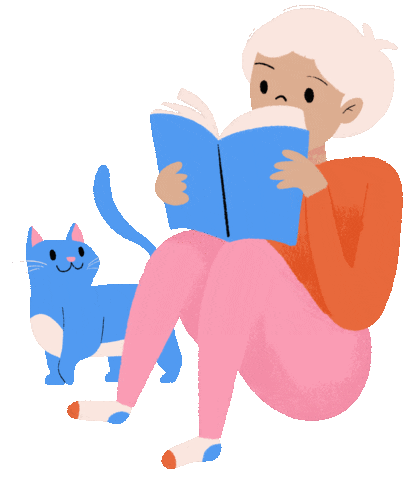
(via GIPHY)
#giphy#transparent#book#kid#books#reading#children#child#bookworm#childrens books#book lovers day#reading is fun#national book lovers day#learning to read
2 notes
·
View notes
Text



Book for sale * PALMER COX Our Brownies ABC Adventures 1898 Lovely replica book alphabet stories https://www.ebay.com/itm/265804845699
Learning to Read, Skill Building, Replica of the 1898 Edition, Some Illustrations in Full Color, Whimsical Brownie Characters, Alphabet adventures. Fully Illustrated. A Book for Children of the late 19th century.
#Childrensbooks #19thcentury #abc #alphabet #bookshop #dance #books #reading #forsale #adventures #read #enjoyable #pleasurable #fun #history
#Book for sale * PALMER COX Our Brownies ABC Adventures 1898 Lovely replica book alphabet stories https://www.ebay.com/itm/265804845699#Learning to Read#Skill Building#Replica of the 1898 Edition#Some Illustrations in Full Color#Whimsical Brownie Characters#Alphabet adventures. Fully Illustrated. A Book for Children of the late 19th century.#Childrensbooks#19thcentury#abc#alphabet#bookshop#dance#books#reading#forsale#adventures#read#enjoyable#pleasurable#fun#history
4 notes
·
View notes
Text
"A story doesn't need a theme in order to be good" I'm only saying this once but a theme isn't some secret coded message an author weaves into a piece so that your English teacher can talk about Death or Family. A theme is a summary of an idea in the work. If the story is "Susan went grocery shopping and saw a weird bird" then it might have themes like 'birds don't belong in grocery stores' or 'nature is interesting and worth paying attention to' or 'small things can be worth hearing about.' Those could be the themes of the work. It doesn't matter if the author intended them or not, because reading is collaborative and the text gets its meaning from the reader (this is what "death of the author" means).
Every work has themes in it, and not just the ones your teachers made you read in high school. Stories that are bad or clearly not intended to have deep messages still have themes. It is inherent in being a story. All stories have themes, even if those themes are shallow, because stories are sentences connected together for the purpose of expressing ideas, and ideas are all that themes are.
#original post#text post#500#1k#2k#btw i know my definition of death of the author is loosey goosey here#it wasn't the main point so i went informal with it! as ppl in the tags have pointed out it isn't exact#and i do recommend reading the wikipedia article or similar (possibly even the essay itself if you're narsty) if you want to learn more!#wasn't expecting this to take off so my apologies to my barthes-heads out there#love you mwah#5k#10k#15k#20k
29K notes
·
View notes
Text
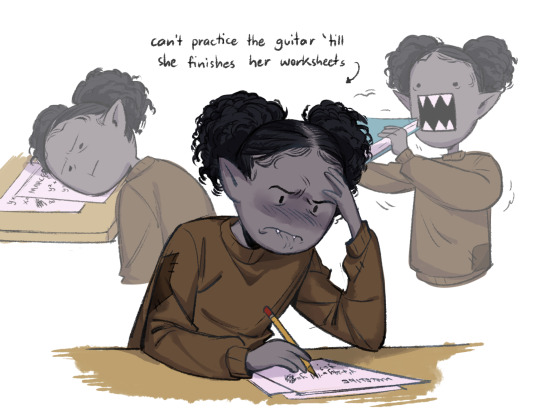
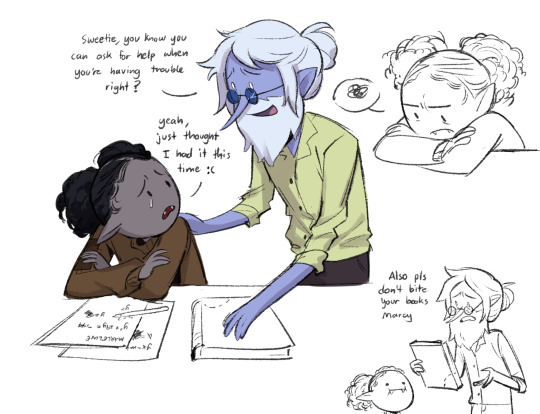

imagine you're living in the post apocalypse and your adopted dad still makes you do homework
#I just think it's cute that Marcy canonically learned how to read and write from Simon#adventure time#marceline abadeer#simon petrikov#fanart#digital art#my art
35K notes
·
View notes
Text
love when ppl defend the aggressive monetization of the internet with "what, do you just expect it to be free and them not make a profit???" like. yeah that would be really nice actually i would love that:)! thanks for asking
#yes i want things to be free like ??? that is not a weird desire#'but but it costs money to keep up' ok and? how is that my problem#the government has plenty of murder dollars they could reallocate a few to make internet services universal if they wanted#also these companies were perfectly capable of supporting themselves before the internet got drowned with ads so ¯\_(ツ)_/¯#edit: muting notifs on this post bc new additions have kind of petered out#so no one feel bad about adding something someone else has said‚ it is not bothering me im just trying to keep my#notifs page cleanish lol#also since i saw some people are being redirected to read my tags: firstly hiiiiii this is a special secret message for you:3#secondly i have learned since making this that the reason they were able to support themselves previously was because#of investors bankrolling everything#and theyre now finally realizing that theyre never going to actually make a profit and arent as willing to invest#however thats just a minor correction and doesnt change my overall point#once again. so many murder dollars#so thats why im just adding it here in the tags rather than making an actual correction#anyways . love yall 💕#origibberish#bigger gibbers
31K notes
·
View notes
Text
#education#parental relationship#literacy#moral stories for kids#reading#animals#cvc#learning to read
0 notes
Text
Walter C. and the Great Meltdown

View On WordPress
#Books#Children&039;s Books#learning to read#literacy#Mom Life#reading#reading books#reading to child#tantrum#teaching child to read#toddlers
0 notes